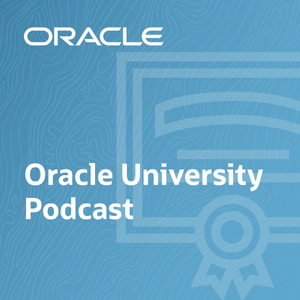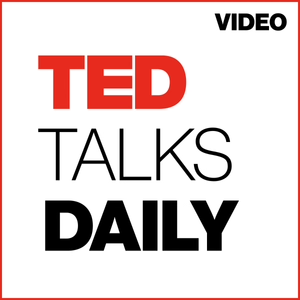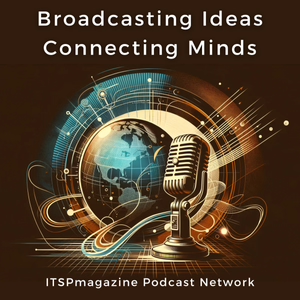
Blockchain Tables
07/30/24 • 16 min
00:00
Welcome to the Oracle University Podcast, the first stop on your cloud journey. During this series of informative podcasts, we’ll bring you foundational training on the most popular Oracle technologies. Let’s get started!
00:26
Lois: Hello and welcome to the Oracle University Podcast. I’m Lois Houston, Director of Innovation Programs with Oracle University, and with me is Nikita Abraham, Principal Technical Editor.
Nikita: Hi everyone! Thank you for joining us as we begin a new season of the podcast. For the next few weeks, we’re going to explore all the new features in Oracle Database 23ai, previously known as 23c. These episodes will be great for you if you’re a database administrator, a developer, or even a database architect.
Lois: Right Niki, and while anyone can listen to the podcast, you’re probably going to get the most out of this season if you have prior knowledge or experience with the previous versions of Oracle Database and have used SQL to manage Oracle Databases. Throughout this season, we’ll discuss new features in database availability, architecture, manageability, performance, and security.
01:21
Nikita: Exactly. Today, we're diving into the world of blockchain tables and the new features introduced. First, we'll try to get an overview of blockchain tables that were introduced in 21c. Then, we'll discuss the new features in 23ai, including row versions, user chains, delegate signer, and countersignature.
Lois: So, let’s get started. To take us through all this, we are joined today by Bill Millar. Bill is a Senior Principal Database & MySQL Instructor with Oracle University. Hi Bill! Thanks for joining us. To begin, what is a blockchain table?
01:59
Bill: Well, a blockchain table provides the means for recording transactions where only insert operations are allowed. And rows are protected or restricted based on time as defined when the table is created. This makes the rows tamper-resistant with their chaining algorithms.
02:16
Nikita: Bill, take us through some common attributes of a blockchain table.
Bill: They are append only, protects the current data in the table. Made tamper-resistant with their hashing algorithm. And optionally, they can be digitally signed. However, they are mandatory in blockchain platform transactions. Transaction logs, audit trails, compliance information, they can most benefit from using blockchain tables.
02:44
Lois: Bill, let’s talk for a minute about the blockchain tables being tamper-resistant. What makes a blockchain table tamper-proof?
Bill: Well, with the insert only tables, each row is going to be chained to the previous row, except the first row. There's nothing to change it to. So once a row is added, it changes it to the previous row, to the previous row. Rows are linked when the transaction commits. We don't link them beforehand because you might roll back.
03:13
Nikita: Do we have some considerations or guidelines for managing blockchain tables?
Bill: One, they may be partitioned. You can specify retention at a table level, the blockchain table itself. You can use the no drop clause. And you can also define it blockchain tables at the row level when you create that blockchain table. Defining a retention period for the table itself or a retention period for the rows.
03:41
Nikita: And are there any restrictions when using blockc...
00:00
Welcome to the Oracle University Podcast, the first stop on your cloud journey. During this series of informative podcasts, we’ll bring you foundational training on the most popular Oracle technologies. Let’s get started!
00:26
Lois: Hello and welcome to the Oracle University Podcast. I’m Lois Houston, Director of Innovation Programs with Oracle University, and with me is Nikita Abraham, Principal Technical Editor.
Nikita: Hi everyone! Thank you for joining us as we begin a new season of the podcast. For the next few weeks, we’re going to explore all the new features in Oracle Database 23ai, previously known as 23c. These episodes will be great for you if you’re a database administrator, a developer, or even a database architect.
Lois: Right Niki, and while anyone can listen to the podcast, you’re probably going to get the most out of this season if you have prior knowledge or experience with the previous versions of Oracle Database and have used SQL to manage Oracle Databases. Throughout this season, we’ll discuss new features in database availability, architecture, manageability, performance, and security.
01:21
Nikita: Exactly. Today, we're diving into the world of blockchain tables and the new features introduced. First, we'll try to get an overview of blockchain tables that were introduced in 21c. Then, we'll discuss the new features in 23ai, including row versions, user chains, delegate signer, and countersignature.
Lois: So, let’s get started. To take us through all this, we are joined today by Bill Millar. Bill is a Senior Principal Database & MySQL Instructor with Oracle University. Hi Bill! Thanks for joining us. To begin, what is a blockchain table?
01:59
Bill: Well, a blockchain table provides the means for recording transactions where only insert operations are allowed. And rows are protected or restricted based on time as defined when the table is created. This makes the rows tamper-resistant with their chaining algorithms.
02:16
Nikita: Bill, take us through some common attributes of a blockchain table.
Bill: They are append only, protects the current data in the table. Made tamper-resistant with their hashing algorithm. And optionally, they can be digitally signed. However, they are mandatory in blockchain platform transactions. Transaction logs, audit trails, compliance information, they can most benefit from using blockchain tables.
02:44
Lois: Bill, let’s talk for a minute about the blockchain tables being tamper-resistant. What makes a blockchain table tamper-proof?
Bill: Well, with the insert only tables, each row is going to be chained to the previous row, except the first row. There's nothing to change it to. So once a row is added, it changes it to the previous row, to the previous row. Rows are linked when the transaction commits. We don't link them beforehand because you might roll back.
03:13
Nikita: Do we have some considerations or guidelines for managing blockchain tables?
Bill: One, they may be partitioned. You can specify retention at a table level, the blockchain table itself. You can use the no drop clause. And you can also define it blockchain tables at the row level when you create that blockchain table. Defining a retention period for the table itself or a retention period for the rows.
03:41
Nikita: And are there any restrictions when using blockc...
Previous Episode

Database Essentials
Join hosts Lois Houston and Nikita Abraham, along with Hope Fisher, Oracle’s Product Manager for Database Technologies, as they break down the basics of databases, explore different database management systems, and delve into database development. Whether you're a newcomer or just need a refresher, this quick, informative episode is sure to offer you some valuable insights.
- Oracle MyLearn: https://mylearn.oracle.com/ou/course/database-essentials/133032/
- Oracle University Learning Community: https://education.oracle.com/ou-community
- LinkedIn: https://www.linkedin.com/showcase/oracle-university/
- X: https://twitter.com/Oracle_Edu
00:00 Welcome to the Oracle University Podcast, the first stop on your cloud journey. During this series of informative podcasts, we’ll bring you foundational training on the most popular Oracle technologies. Let’s get started!
00:26 Nikita: Hello and welcome to the Oracle University Podcast. I’m Nikita Abraham, Principal Technical Editor with Oracle University, and with me is Lois Houston, Director of Innovation Programs.
Lois: Hi there! For the last seven weeks, we’ve been exploring the world of OCI Container Engine for Kubernetes with our senior instructor Mahendra Mehra. We covered key aspects of OKE to help you create, manage, and optimize Kubernetes clusters in Oracle Cloud Infrastructure. So, be sure you check out those episodes if you’re interested in Kubernetes.
01:00
Nikita: Today, we’re doing something a little different. We’ve had a lot of episodes on different aspects of Oracle Database, but what if you’re just getting started in this world? We wanted you to have something that you could listen to as well. And so we have Hope Fisher with us today. Hope is a Product Manager for Database Technologies at Oracle, and we’re going to ask her to take us through the basics of database, the different database management systems, and database development.
Lois: Hi Hope! Thanks for joining us for this episode. Before we dive straight into terminologies and concepts, I want to take a step back and really get down to the basics. We sometimes use the terms data and information interchangeably, but they’re not the same, right?
01:43
Hope: Data is raw material or a set of facts and observations. Information is the meaning derived from the facts. The difference between data and information can be explained by using an example, such as test scores. In one class, if every student receives a numbered score and the scores can be calculated to determine a class average, the class average can be calculated to determine the school average. So in this scenario, each student's test score is one piece of data. And information is the class’s average score or the school's average score. There is no value in data until you actually do something with it.
02:24
Nikita: Right, so then how do we make all this data useful? Do we create a database system?
Hope: A database system provides a simple function—treat data as a collection of information, organize it, and make the data usable by providing easy access to it and giving you a place where that data can be stored. Every organization needs to collect and maintain data to meet its requirements. Most organizations today use a database to automate their information systems. An information system can be defined as a formal system for storing and processing data. A database is an organized collection of data put together as a unit. The rationale of a database is to collect, store, and retrieve related data for use by database applications. A database application is a software program that interacts with the database to access and manipulate data. A database is usually managed by a Database Administrator, also known as a DBA.
03:25
Nikita: Hope, give us some examples of database systems.
Hope: Popular examples of database systems include Oracle Database, MySQL, which is also owned by Oracle, Microsoft SQL server, Postgres, and others. There are relational database management systems. The acronym is DBMS. Some of the strengths of a DBMS include flexibility and scalability. Given the huge amounts of information that modern businesses need to handle, these are important factors to c...
Next Episode

Database Security: Part 1
Join hosts Lois Houston and Nikita Abraham, along with Senior Principal Database & Security Instructor Ron Soltani, as they dive into the critical topic of database security. In the first of a two-part series on database security in Oracle Database 23ai, they discuss the importance of protecting data against external and internal threats, common security risks like phishing and SQL injection, and the principle of least privilege. Oracle MyLearn: https://mylearn.oracle.com/ou/course/oracle-database-23ai-new-features-for-administrators/137192/207062 Oracle University Learning Community: https://education.oracle.com/ou-community LinkedIn: https://www.linkedin.com/showcase/oracle-university/ X: https://twitter.com/Oracle_Edu Special thanks to Arijit Ghosh, David Wright, and the OU Studio Team for helping us create this episode. -------------------------------------------------------- Episode Transcript:
00:00
Welcome to the Oracle University Podcast, the first stop on your cloud journey. During this series of informative podcasts, we’ll bring you foundational training on the most popular Oracle technologies. Let’s get started!
00:26
Nikita: Hello and welcome to the Oracle University Podcast. I’m Nikita Abraham, Principal Technical Editor with Oracle University, and joining me is Lois Houston, Director of Innovation Programs.
Lois: Hi there! In case you missed last week’s episode, we’ve begun a new season of the podcast, talking about all the new features in Oracle Database 23ai. We covered blockchain tables and new features, and today’s episode is going to be one of two that will be dedicated to database security.
Nikita: Right, Lois. So, in Part 1, we want to set the scene, so to speak, by looking at an overview of database security so that when we discuss some of the new features, we’ll know exactly where they actually fit into the process. Joining us for these two episodes is Ron Soltani. Ron is a Senior Principal Database & Security Instructor with Oracle University.
01:16
Lois: Hi Ron! Thanks for being with us today. To start off, let's discuss the importance of database security. Why is database security so critical today?
Ron: Security requirements, describes the need for keeping things private and make sure that we protect against threat, against data destruction. We also have, today, data that is global. Therefore, there is consolidation of the data. There is globalization.
There is data sourcing, locational, where the data is actually located, rules opposed by different governments, and guidelines that enforce a certain type of security administration on the data. And finally, there are many different companies or organizations that actually come up with either guidelines or rules that must be followed for security aspect that we must set up and build compliance.
02:24
Nikita: Ron, what are some of the common security risks that databases face?
Ron: Security risk can include external threats that could be unauthorized users trying to use phishing, get privileged user information, and get in as a privileged user to do whatever damage they want. Denial-of-service attack, one of the most common attacks out there where the attackers just create or attack the components, like a listener, for example, in a database, and cause a situation where the listener can no longer establish connection to the database. So now no client can connect to the database to get data, which is that denial-of-service attacks.
Having unauthorized access to the data-- so again, this is generally done through phishing or sometimes even SQL injection. SQL injection also allows you to insert SQL statement in the application where it's not expected, where it can then convert into an executable in the database and then have unwanted data returned for the user.
03:42
Nikita: Sorry, can you explain that?
Ron: For example, when you go to Google, you want to run a search. They expect you to say, meaning of a particular word. Now, what if I knew the structure of the data organization in Google? And instead of just putting in meaning of whatever word, I actually plug in a SQL statement that then passed along to the Google system to be executed. And then that SQL, if the components and everything exist and within the privileges of what is being executed, could expose some information to me. So that's the idea with being able to pe...
If you like this episode you’ll love
Episode Comments
Generate a badge
Get a badge for your website that links back to this episode
<a href="https://goodpods.com/podcasts/oracle-university-podcast-388362/blockchain-tables-64991368"> <img src="https://storage.googleapis.com/goodpods-images-bucket/badges/generic-badge-1.svg" alt="listen to blockchain tables on goodpods" style="width: 225px" /> </a>
Copy




